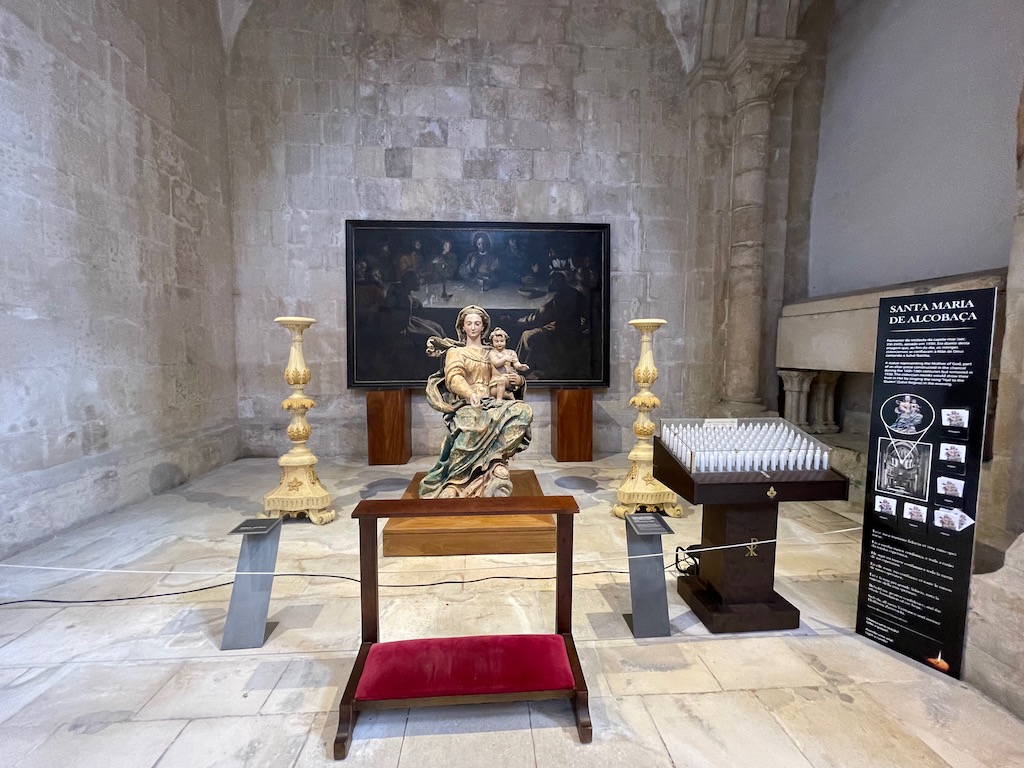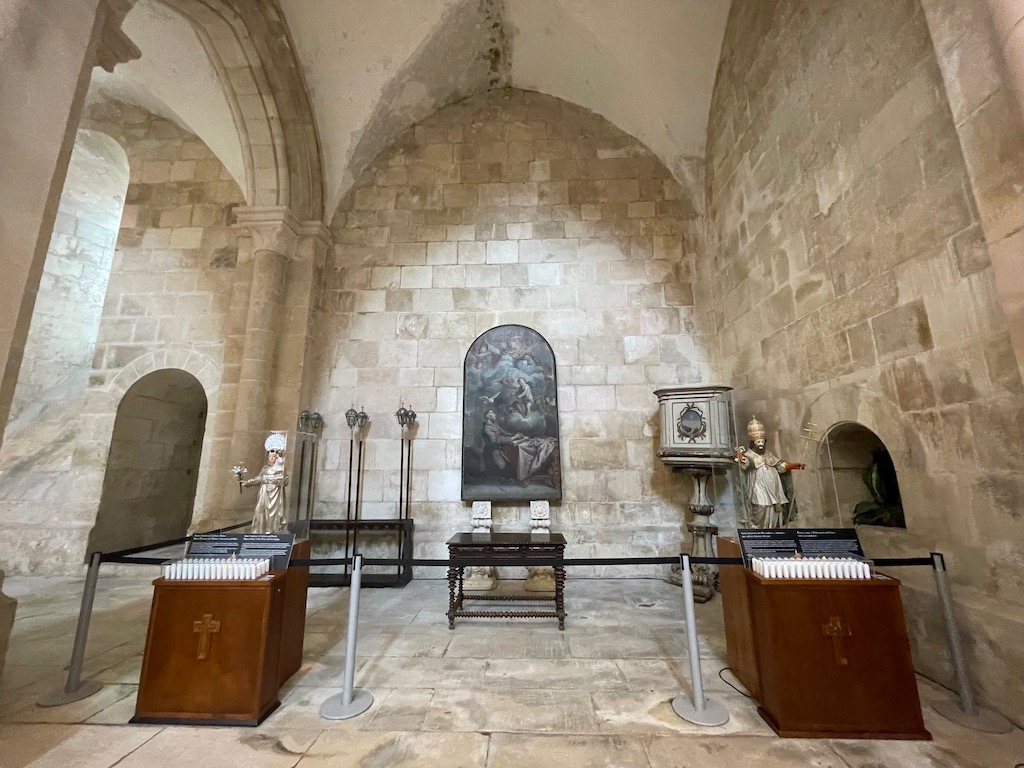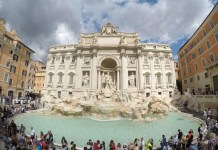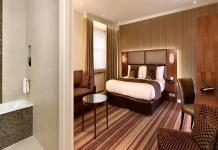Last updated: 09/28/2022
Check out all the information and tips to visit the historic and beautiful Monastery of Alcobaça, which houses the tombs of D. Pedro I of Portugal and Inês de Castro.
THE MONASTERY OF ALCOBAÇA
The Royal Monastery of Santa Maria de Alcobaça, more commonly called the Monastery of Alcobaça, is a monastery of great historical importance located in the city of Alcobaça, in the district of Leiria, in central Portugal. It is located about 215 km south of the city of Porto, 110 km south of Coimbra and 120 km north of Lisbon.

The Alcobaça Monastery was founded in 1153 by the first king of Portugal, Afonso Henriques, who donated around 44 thousand hectares of land to São Bernardo de Claraval and to the monks of Order of Cistercian, a reformed Benedictine Catholic monastic order that wears white religious robes, after defeating the Moors and reconquering the lands of the region (Read more: Guimarães Castle: The beginning of Portugal's history). Built in 1178 and inaugurated in 1252, this monastery is the first completely Gothic work built in Portugal and has been expanded and renovated over the centuries.

However, in 1834, the monks were forced to abandon the monastery due to the extinction of all religious orders in Portugal in the context of the Pombaline Reform. As a result, several areas of the monastery became public and administrative offices. Between 1928 and 1948, the Portuguese government carried out a series of reforms with the aim of recovering the monastery's historical importance, restoring its architecture and some of its previous functions. In 1989, the monastery entered the list of UNESCO World Heritage Sites and, in 2007, was elected one of the Seven Wonders of Portugal.

>> CONSTRUCTION THROUGHOUT THE CENTURIES
The first areas built in the Monastery of Alcobaça were the church and the monastic wings. In the 13th century, the Chapter Room, Dormitory, Monks' Room and the Refectory were built. In 1308, D. Dinis ordered the construction of an enormous cloister, initially known as Cloister of Silence, the largest Portuguese medieval cloister. In the 14th century, it began to house the tombs of D. Pedro I of Portugal and D. Inês de Castro, who were the protagonists of one of the most famous (and tragic) love stories of the Middle Ages.


In the 16th century, during the reign of D. Manuel, the Bookstore, the New Sacristy, the Sobreclaustro (first floor of the Cloister of D. Dinis), the Sala dos Reis and the Abacial Palace were added. In the 17th century, new structures were built, including the Sala das Conclusions, Cloister of the Portaria and Hostel and Cloisters of Rachadouro, where the workshops, the archive and the library were located. Then, the Chapel of the Reliquary, also called “O Espelho do Céu”, and the sculptural group “Morte de São Bernardo” were built. In the 18th century, the Capela do Desterro, Cozinha Nova and Sacristia Nova were built. Finally, in 1770, the Sala dos Túmulos or Royal Pantheon in neo-Gothic style was built.

>> ARCHITECTURE OF ALCOBAÇA MONASTERY
Today, the church's facade is a mixture of styles: the Gothic portico and the rose window above were part of the original church, while the statues of Saint Benedict and Saint Bernard and the two side bell towers were added in the early 18th century, in Baroque style. The monastery is formed by a church next to the medieval sacristy. The church and the first cloister were built in an early Gothic style. The entrance staircase also has Baroque-style decorations. In 1930, a renovation was carried out to rebuild the church along the lines of the medieval period, removing several elements that had been added over the centuries.



TOURS AND EXCURSIONS TO THE MONASTERY OF ALCOBAÇA
For those who want all the convenience of an excursion or guided tour, there are many of them! The most famous are those that leave Lisbon and include a visit to the Monastery of Alcobaça, including other places such as the Sanctuary of Fátima, Nazaré and the charming medieval town of Óbidos. The tours are very practical for those who do not want to rent a car or depend on public transport, have little time, and/or like to have a specialized guide explaining everything about the places visited. Check out some of the options below.
WHAT TO VISIT IN ALCOBAÇA MONASTERY
The Alcobaça Monastery is made up of several historic rooms. In addition to its beautiful church, some of the monastery's highlights are the Kitchen, the Refectory, the Chapter Room, and the Chapel of Relics. In case you want to make a quick visit, our suggestion is to go straight to the Church, where the tombs of D. Pedro I of Portugal and D. Inês de Castro are, as the entrance is free. If you want to do the complete circuit, visiting all the environments of the old monastery, you will need to buy a ticket. To do this, looking at the church from the front, go to the left side where you will find the ticket office. Then learn more about some of the most important areas of the Alcobaça Monastery.

1. CHURCH
erected with a Latin cross plant, the church is formed by a grand central nave and two side aisles that are about 20 meters high and are vaulted, giving a feeling of spaciousness. At 106 meters long, the church is one of the largest Cistercian abbeys in the world and follows an austere architecture, which seeks to show the humility of the Benedictine monks. The Church has a ambulatory, a complex structure in which the nave of the church surrounds the high altar.



>> TOMBS OF D. PEDRO I & D. INÊS DE CASTRO
In the transept of the church are the tombs of D. Pedro I and his beloved, Inês de Castro, who was murdered in 1355 by order of D. Pedro's father, D. Afonso IV, in Coimbra (Read more: Coimbra: Quinta das Lágrimas and the tragedy of Inês de Castro). After becoming king, Pedro ordered the remains of his beloved to be transferred to her tomb in Alcobaça and, according to popular legend, crowned her as Queen of Portugal and ordered the members of the court to pay homage to her by kissing her hand in decomposition.


The sides of the tomb of D. Pedro I are decorated with reliefs that show scenes from the life of Saint Bartholomew, as well as scenes from the lives of Pedro and Inês. Agnes' tomb is decorated with scenes from the life of Christ, including the Crucifixion and the Last Judgment.


>> ALTAR OF THE DEATH OF SÃO BERNARDO
Another highlight of the church is the Altar da Morte de São Bernardo, which consists of a chapel, located on the south side of the transept, which has a sculptural group representing the “Death of São Bernardo”, one of the best works by monks from Alcobaça. of the seventeenth century. On each side of the chapel are buried Kings Alfonso II and Alfonso III.

>> ROYAL PANTHEON OR ROOM OF TOMBS
This room was built in the 18th century in neo-gothic style, being the oldest architecture in this style in Portugal. The Royal Pantheon has the 13th century tombs of two queens of Portugal, Urraca of Castile (wife of King Alfonso II) and Beatriz of Castile (married to King Alfonso III) and also of some infants.


>> SACRISTY, RELICARY CHAPEL AND CHAPEL OF THE HOLY HOLY
With about 100 m², the Medieval Sacristy is located at the top of the left side of the church's transept. At the beginning of the 16th century, during the reign of D. Manuel, it was replaced by the Sacristia Nova, which was more than twice as big. The New Sacristy was built in the Manueline style at the beginning of the 16th century, but had to be rebuilt after the earthquake of 1755. The access corridor to the sacristy, covered by a Manueline vault, and the sacristy portal survived the quake. The portal is framed by intertwined branches that bear the coat of arms of Portugal.


It is integrated into the Sacristia Nova the Reliquary Chapel, a chapel with an octagonal floor plan and an interior completely covered with gilded carving and 89 reliquary sculptures that are located in niches distributed over six levels. In the center, there is an opening through which natural light enters. The same atrium that gives access to the sacristy also leads to the Capela do Santíssimo, also known as Capela do Senhor dos Passos, a chapel that was destroyed during the very strong earthquake of 1755. When it was rebuilt, the Manueline portals were preserved.


2. ROOM OF THE KINGS
This room, located next to the entrance to the church, houses 19 statues from the 17th and 18th centuries representing the kings of Portugal. In the past, it was used as the Royal Pantheon and People's Church. The walls are decorated with blue and white 18th century tiles that tell the story of the Monastery of Alcobaça, since its foundation. At the back of the room, there is the allegorical representation of the coronation of D.Afonso Henriques with Pope Alexandre III and São Bernardo.

3. D. DINIS OR SILENCE CLOSURE
The monastery's cloister was built during the reign of D. Dinis. This is one of the largest medieval Cistercian cloisters in Europe. The columns are decorated by capitals with animal and plant motifs. The Gothic Fountain Room has an elegant water basin from the beginning of the Renaissance, decorated with Renaissance motifs, including the monastery's coat of arms. The second floor of the cloister, in Manueline style, has twisted columns and was built in the early 16th century.



4. CHAPTER & PARLATORY ROOM
This room, where the monks met to discuss the daily affairs of the monastery, was the most important room after the church. The entrance to the house is through a Romanesque-style portal with two similar windows on each side. The room is now filled with Baroque statues created by the monks for the church's chancel.

The parlor is a small room about 5 meters wide that is next to the Chapter Room. In the past, it was only here that monks were allowed to speak with their superiors, as they had taken a vow of silence. Monks could only communicate through signs and could only make sounds when they prayed.
5. MONKS' ROOM
The Sala dos Monges is a room of about 550 m² that, initially, functioned as a dormitory for the monks. However, it was later turned into a living room for the monastery's monks. In the 17th century, after the construction of the new kitchen, this room became a place for storing food and goods.

6. KITCHEN
THE kitchen medieval monastery was destroyed during the 17th century, retaining only the romantic-style door. The current kitchen was built in the 18th century between the Refectory and the Sala dos Monges and is covered with tiles both on its internal walls and on its huge central chimney, supported by eight iron columns.

7. DINING ROOM
Located next to the kitchen, the refectory it was the room where the monks had their meals every day. The structural complexity of the refectory is impressive and the structure is formed by three vaulted aisles, divided by two rows of four columns. As they ate, one of the monks read aloud passages from the Bible from a pulpit, which is built into one of the walls and can be accessed via a small staircase. In front of the refectory is a “lavabo”, a type of fountain that indicated the Wash Room, where the monks could wash themselves before meals.


8. HOSTEL OR DORMITORY CLOSURE
With about 1,300 m², the bedroom is on the first floor and there are two stairs to access it (at the entrance to the kitchen and in the cloister). In the past, monks slept on primitive mattresses next to each other. However, from the 14th century onwards, divisions were built in order to have individual areas.

ALCOBAÇA MONASTERY STORE
In the former Sala das Conclusions, there is the gift shop of the Monastery of Alcobaça with religious articles, books, accessories, postcards and many other gift items. In the past, it was this room that houses the statues of Portuguese kings that are currently housed in the Sala dos Reis.

IMPORTANT INFORMATION
Alcobaça Monastery
- Address: 2460-018 Alcobaça, Portugal
- Schedules: daily from October to March from 9 am to 6 pm | April to September from 9 am to 7 pm
- Entrance: free for church | pay for the monastery
- Single ticket: €6
- Sacristy Ticket: €2
- World Heritage Ticket: €15 (includes Alcobaça Monastery, Convent of Christ and Batalha Monastery) – valid for 1 year
- Thematic Visits: groups of up to 10 people lasting 1 hour – learn more here
Save this tip on Pinterest!

Read more about Portugal:
HARBOR
- Portugal: What to do in Porto – 2 or 3 days itinerary
- Portugal: How to get from Porto Airport to the center
- Port: Hotel One Shot Aliados Goldsmith 12
- Portugal: Guided Tour of the beautiful Palácio da Bolsa in Porto
- Restaurante Onze: Haute cuisine in Porto
- Porto: Restaurant Francesinhas Al Forno da Baixa
- Cálem: Tour in the most visited cellar in Port Wine
- Vices at the Table – Bad Habits: Pizza and culture in Porto
- Porto.CARD: Savings tip in the city of Porto
- Porto: Lello Bookstore, the most beautiful bookstore in the world
- Portugal: Ribeira Square Restaurant in Porto
- Kind Kitchen: Casual Vegan Food in Porto
- Portugal: Curiosities and Tours on the 6 Bridges of Porto
LISBON
- Portugal: How to get from Porto Airport to the center
- Lisbon accommodation tip: Brown's Downtown Hotel
- Portugal: What to do in Lisbon – 3 days itinerary
- Portugal: Guide to where to eat in Lisbon (with map!)
- Lisbon: Dinner with Fado performances at Adega Machado
- Lisbon Card: Savings tip in the Portuguese capital
- Portugal: The historic Jerónimos Monastery in Lisbon
- Portugal: How to visit São Jorge Castle in Lisbon
- Portugal: Visiting the Belém Tower in Lisbon
- Portugal: How to get from Lisbon Airport to the center
- Portugal: Discover the National Pantheon in Lisbon






